The Bund
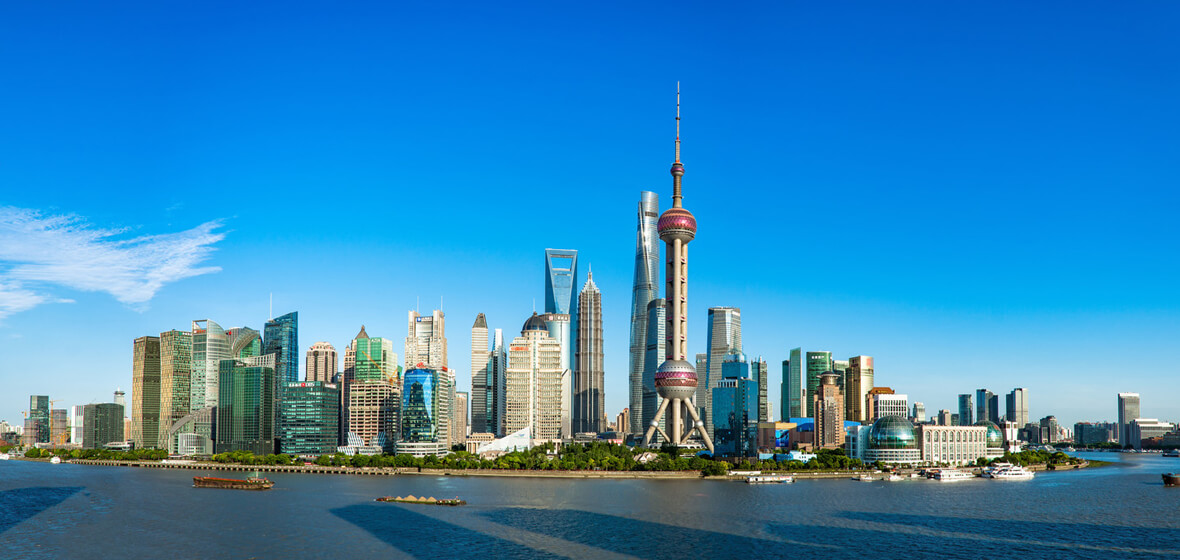
Known in Chinese as the Wai Tan (outer beach), the Bund is Shanghai’s prominent waterfront promenade. The 1.5-kilometer-long Bund stretches from East Yan’an Road in the south to the Garden Bridge on the Suzhou River in the north, with Huangpu River to the east and the cluster of old Shanghai financial and foreign trade institutions to the west. Since 1943, the Bund has been named East Zhongshan No.1 Road and is a must-see for travelers to Shanghai. No place in Shanghai reflects the city’s evolution quite like the Bund, where every building and landmark tells a story. With magnificent architecture, it provides photo opportunities, places to relax as well as shops and hotels, The Bund truly has it all!
A Brief History of the Bund
In the late 1700s, European nations such as Britain, the Netherlands, and France wanted access to export their finished products to China. However, the Qing Government of China limited them to the commercial port of Canton (Guangzhou), did not allow them to learn Chinese, and also threatened harsh penalties for any European who tried to leave the port city and enter further into China. On the other hand, Europeans fancied the Chinese silks, porcelain, and tea. The Qing government required payment in silver for all the international trade. Britain soon faced a serious trade deficit with China. To counter the trade deficit caused by British demand for Chinese goods, the British-owned East India Company (EIC) began importing opium to China. By the early 1800s, there were 10-12 million opium addicts in China. The Qing Government's attempt to prevent the import of the drug from entering their country resulted in two major conflicts-two Opium Wars.
After losing the First Opium War to the British in 1842, under the Treaty of Nanking, China was forced to open up five of its major ports, including Shanghai, to foreign trade. As a result, the British were granted the right to settle along the Huangpu River where the Bund is today. Soon wharves and trading houses were set up along the Huangpu River.
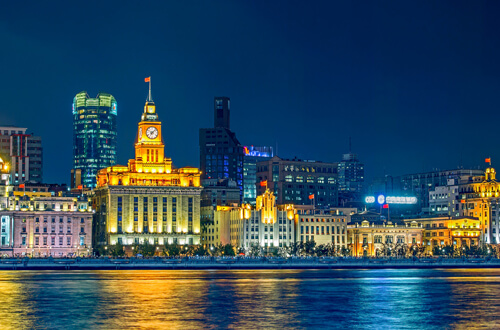
In 1844, The United States government forced China to sign the Treaty of Wangxia (officially: Treaty of Peace, Amity, and Commerce between the United States and China), China opened five ports, including Shanghai, to US merchants. The American settlement in Shanghai covered the north bank of the Huangpu River, northeast of the Bund, which was then part of the British concession.
In 1863, the American concession officially joined the British Settlement to become the Shanghai International Settlement, which saw the Bund grow further. As Shanghai grew to be a bustling trading center in the Yangtze Delta, the Bund's warehouses and ports became the heart of the action. By the late-1860s Shanghai's official governing body had been practically transferred from the individual concessions to the Shanghai Municipal Council (工部局, literally "Works Department", from the standard English local government title of 'Board of Works’).
A building boom at the end of the 19th century and the beginning of the 20th century led to the Bund becoming a major financial hub of East Asia. British colonial style and neoclassical buildings were built along the Bund. The early 20th century saw the additional construction of buildings housing offices of many important financial institutions on the Bund. These included the Hong Kong Shanghai Banking Corporation (HSBC) and the Imperial Bank of China (the first Chinese-owned bank in Shanghai).
From 1920 to 1937, the architectural style was grander and gaudier, and the Bund reached its peak. Alongside the banks, social clubs like the highly exclusive Shanghai Club and glamorous hotels were built to accommodate wealthy tourists. The Bund became synonymous with alcohol, jazz, celebrity, and capitalism.
In 1941, the Japanese Army entered and occupied the Bund in the wake of the attack on Pearl Harbor.
Since the Allies had renounced their treaty rights in China during the war, foreign concessions in Shanghai were not restored after Japan’s defeat in 1945.
The Highlights of Bund
1. Admire the skyline of Shanghai
The Bund is the best place to admire the skyline of Shanghai. Some of the highest buildings in China like Shanghai Tower, Shanghai International Financial Tower, and Jinmao Tower located across the Huangpu River in Pudong. At night you can see all the illuminated buildings of Shanghai which are in contrast with the old architecture of the Bund.
2. Admire colonial architecture
The Bund houses 52 buildings of various architectural styles such as Romanesque, Gothic, Renaissance, Baroque, Neo-Classical, Beaux-Arts, and Art Deco (Shanghai has one of the richest collections of Art Deco architectures in the world), which cannot be missed. Here are some of the best
Asia Building
originally the McBain Building, housed the Shanghai offices of Royal Dutch Shell and Asiatic Petroleum Company. It was the tallest and one of the largest buildings in Shanghai upon its completion in 1916, hence its widespread nickname 'Number One Building on the Bund'.
Shanghai Club
Built in 1910, it was the principal social club for British nationals in Shanghai. The building is an English Renaissance, Baroque Revival style, with Corinthian columns and arched windows on a whitewashed façade. Now it is the Waldorf-Astoria Shanghai on The Bund Hotel.
Union Building
Completed in 1916, the building was used by several insurance companies. It was the first building in Shanghai to use a steel structure. The building is in Neo-Renaissance style with a symmetrical facade, but with some Baroque style details. The roof features a domed corner pavilion. Today, it is a shopping center, called “Three on the Bund”.
China Merchants Bank Building
Completed in 1907 and housed the first Chinese-owned bank in China. It is a building in the style of Victorian Gothic. The windows in the gables or dormers are fan-shaped.
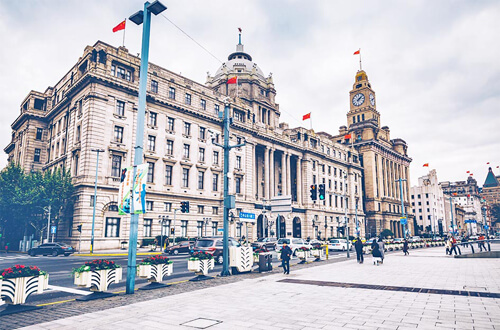 The HSBC Building
The HSBC Building
The HSBC Building
Completed in 1923, it was called "the most luxurious building between the Suez Canal and the Bering Strait". The structure had a neoclassical style with ornate interiors of marble and Monel. The entire building was fitted with air conditioning and heating equipment. It has a spectacular dome with 8 mosaic murals depicting the cities where the main branches of the HSBC bank were located. Now it is used by the Shanghai Pudong Development Bank.
The Customs House
It was built in 1927 on the site of an earlier, traditional Chinese-style customs house. The structure has a Greek revival neoclassical design. The exterior is made of red brick and granite. The grand main hall is decorated with marble and gold leaf with an octagonal dome surrounded by mosaics. It has eight floors and a clock tower that offers spectacular views of the Bund and the city. The clock and bell were built in England in imitation of Big Ben.
The Peace Hotel
Opened in 1929 as the luxurious Cathay Hotel, this building has a striking Art Deco façade and iconic green copper dome, both recently restored to their former glory. It was owned by property tycoon Sir Victor Sassoon, whose business empire was built on the opium trade. This place also hosted many dignitaries and foreign envoys, boasting innovations, such as room telephones, ahead of any European hotel. With six floors and 120 guest rooms, it was the first hotel in Shanghai to have two elevators. Among other luxuries, there were a private plumbing system, marble baths with silver taps, as well as enamel-coated lavatories imported from Britain. Now called Fairmont Peace Hotel, the ground floor cafe offers great people-watching opportunities with seats by the windows, while the rooftop bar on the 9th floor offers evening drinks with a stunning view of the Bund and Pudong ablaze with night illumination. If you are in the mood for some slow-paced classical jazz with a chance to swirl or sip a cocktail to the nostalgic tunes played by a group of lively 80-year-olds, then head to the hotel's Jazz Bar, reminiscent of those bars in the 1920s and 30s, featuring the Old Jazz Band.
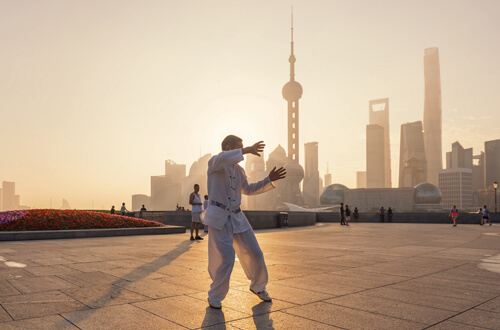 Tai Chi
Tai Chi
3. Watch local people’s life
You’ll spot locals doing Tai Chi, flying kites, walking, and jogging. It is a busy area so if you like watching the world go by, you’ll have a great time doing so here!
4. Enjoy the local and international cuisine
There are lots of great places to eat within close vicinity of The Bund. Many places have great views of The Bund as well. There’s plenty to choose from, and there should be something to suit everyone.
5.Visit the Bund Bull
Less known to most tourists is the Wall Street Charging Bull's brother. At 5.2-meters long, 3.2-meters high, and a whopping 2.5 tons in weight, it is almost identical to the original Wall Street Bull on which it is based – only “redder, younger and stronger,” according to the artist of both, Arturo Di Modica.
Best Time of Day to Visit the Bund
The best time to visit the Bund is mostly in the morning or afternoon on sunny, clear days as the view across the water to Lujiazui is picturesque. In the evening, you will enjoy the lit-up silhouettes of all the modern buildings in Pudong (on the opposite side of the river) and the old architectural buildings behind you.
As it is a must-see spot for visitors to Shanghai, during the national holidays, festivals, and weekends, be aware of the crowds. It is ideal to visit during the weekdays.
The Attractions Near the Bund
There are several interesting places within walking distance of the Bund. To get to Pudong, you can take the ferry at the Pujiang Tourist Wharf on Jinling East Road. The ferry will take you to Dongchang Road Wharf in Pudong. The Sightseeing Tunnel is a cross-river tunnel from East Nanjing Road to the Oriental Pearl Tower in Pudong. You can reach the other side of the river by the escalator in the tunnel under the Huangpu River.
Nanjing Road Pedestrian Street
Nanjing Road stretches about 5 km (6 miles) in total and boasts retailers from all over the world, in addition to local shops and department stores. It is known as the busiest shopping street in the world. During the day, you can admire the graceful architecture of the surrounding buildings. At night, you'll marvel at the illuminated logos and brand names that line the avenue.
People's Square
People's Square is the biggest public square in Shanghai. It is the political and cultural center combining culture, history, and beautiful landscapes. People’s Park is part of the square. You should not miss the Matchmaking corner (Marriage Market) located right in People’s Park. It is a place for parents to advertise their unmarried kids, and search for a perfect match for them.
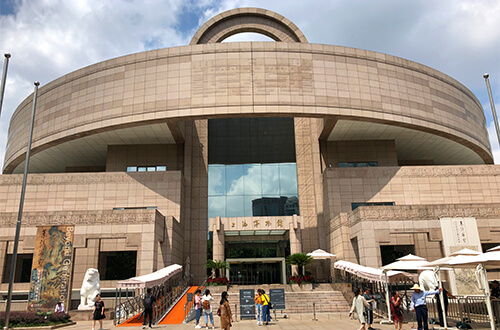 Shanghai Museum
Shanghai Museum
Shanghai Museum
It is considered one of China’s first world-class modern museums. The museum was first founded in 1952 and was located at the former Shanghai Racecourse Club House. Visitors can enjoy the museum’s collection of over 120,000 pieces, which includes ceramics, bronze, calligraphy, furniture, jades, ancient coins, seals, sculptures, paintings, minority art, and foreign art. The museum is free but closed on Mondays.
Yuyuan Garden and Yuyuan Market
Initially built between 1559 and 1577 in the Ming Dynasty, the garden was destroyed several times and later restored to its former glory. One defining feature of Yuyuan Garden is the carefully created sense of space within small confines using narrow lanes, strategically placed partitions, and windows that provide frames for portrait view. In the garden, you will enjoy the historic culture of Chinese architecture. Just behind the Yuyuan Garden is the Yuyuan Market. There you can find a variety of tasty snacks, trinkets, and souvenirs. The delicious steamed meat dumplings (xiaolong bao) is a must, that should not be missed.
Waibaidu Bridge(Garden Bridge)
Waibaidu Bridge was built in 1906 to replace the former wooden bridge and was constructed to accommodate both trams and cars. In 2008 the bridge was entirely dismantled and taken to a shipyard to be restored to its former glory using the original blueprints which city engineers had managed to track down. The bridge, which offers spectacular views of the Bund and Shanghai at large, is a popular spot for shooting TV shows and movies. It has even been featured in several Chinese novels.
How to get the Bund:
- Bus: Take No. 576, 317, or 868 and get off at the Guangdong Road Station on East Zhongshan No.1 Road.
- Subway: Take Line 2 or 10 and get off at Nanjing East Road Station and walk to get there.
Drop us a line and we'll connect you with the top China expert in no time!